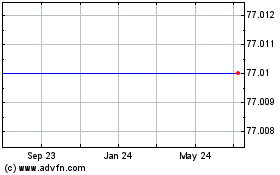Bob Evans' Activist Shareholder Battles with Board He Helped Pick
March 10 2016 - 5:00PM
Dow Jones News
An activist shareholder has a beef with the board he helped
install at Bob Evans Farms Inc.
Thomas Sandell won a third of the company's 12 board seats in an
August 2014 proxy fight. The revamped board subsequently shot down
one of Mr. Sandell's main ideas for Bob Evans: a separation of the
packaged-foods unit from its restaurant-chain business.
Now Mr. Sandell's firm, Sandell Asset Management Corp., which
owns nearly 7% of Bob Evans' shares, is waging a noisy campaign
against the board he helped select.
Since December, Mr. Sandell has sent board members several
letters urging them to consider separating the highly profitable
unit that sells Bob Evans branded sausages, macaroni and cheese and
potatoes in grocery stores throughout the U.S. He also has pushed
the idea of a spinoff or split during 30 meetings with Bob Evans
officials since his proxy fight.
Last week, Mr. Sandell ratcheted up the pressure when he asked
Bob Evans CEO Saed Mohseni what the company was doing to unlock the
value of the packaged-foods unit during an earnings call.
If they can't reach a compromise, Sandell could wage another
proxy fight. Shareholders can propose board candidates between
April 21 and May 21 for this summer's annual meeting.
Fights between activist shareholders and public-company boards
are common these days. But a public spat between an investment fund
and a board of directors it helped reshape "is unusual," said Suraj
Srinivasan, a Harvard Business School professor who studies the
impact of activist board members. "I can't think of a similar
case."
Bob Evans, which previously hired investment bank Lazard Ltd. to
review options, concluded in March 2015 that the packaged-foods
business was too small to be a stand-alone company and that the
move could result in hefty taxes. The Internal Revenue Service is
considering changing rules for spinoffs, which means they wouldn't
necessarily be tax free.
During Bob Evans' March 2 earnings call, Mr. Sandell argued that
the packaged foods business, which has improved since last year,
could be worth more than $1 billion as a stand-alone enterprise.
That would exceed the $976 million market cap for the entire
company.
"Valuations in this space have rarely been higher and there is
no guarantee the iron will stay hot," Mr. Sandell said in a
statement in a response to a Wall Street Journal query.
The Bob Evans restaurant business, however, has been struggling.
The chain of 548 family-style restaurants in 18 states, located
mostly in the Midwest, mid-Atlantic and Southeast, posted a 3.6%
decline in same-store sales in its fiscal third quarter.
Douglas Benham, Bob Evans chairman and a Sandell board pick, has
a different view. "Our results have gotten better, so any potential
transaction would have a better return at this stage of the game,"
he said in an interview. "But the tax issues haven't changed."
Nor do Bob Evans board members want to do something "that's
going to make the stock go up on a short-term basis without
creating sustainable long-term value," Mr. Benham added.
The revamped board has taken numerous steps that Sandell
favored, including hiring a new chief executive, selling the
corporate jet and increasing stock buybacks and dividends.
"A lot of good things have happened since the proxy fight," a
person familiar with Sandell said. But finding a way to extract
value from the packaged-foods business remains "an incredibly
important piece of the puzzle."
In the fiscal third quarter ended Jan. 22, operating income for
the packaged-foods unit rose 26% compared with a year ago as the
company consolidated plants, made them more efficient and sold more
refrigerated side dishes, which carry higher margins than
sausage.
Overall, "the business is much more profitable now than it was
12 months ago and my hope is it will be even more profitable in
another 12 months," Mr. Mohseni, who took the helm in January, said
in an interview.
Sandell would like Bob Evans to spin off rather than sell the
packaged foods business so that shareholders benefit twice—first by
acquiring shares in the new company and then by getting a bump when
the stand-alone business sells.
Though Bob Evans directors "haven't ruled out anything," they
won't separate the unit simply because Mr. Sandell likes the idea,
another person familiar with the matter said. "Companies can't run
on one investor's time frame," this person said.
(END) Dow Jones Newswires
March 10, 2016 16:45 ET (21:45 GMT)
Copyright (c) 2016 Dow Jones & Company, Inc.
Bob Evans Farms (NASDAQ:BOBE)
Historical Stock Chart
From Jun 2024 to Jul 2024

Bob Evans Farms (NASDAQ:BOBE)
Historical Stock Chart
From Jul 2023 to Jul 2024
